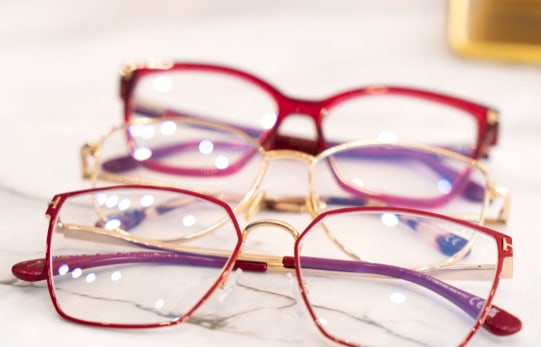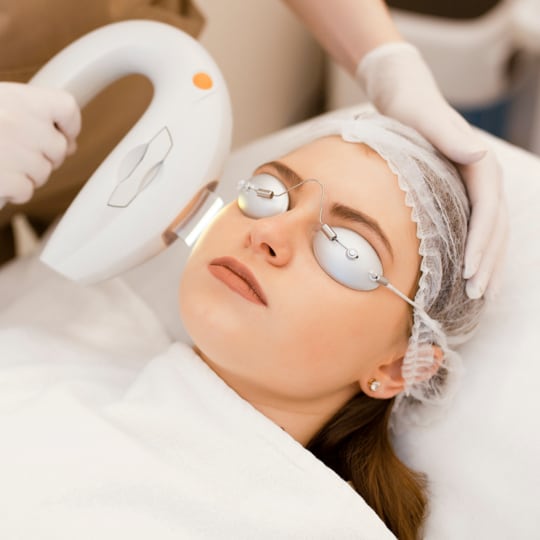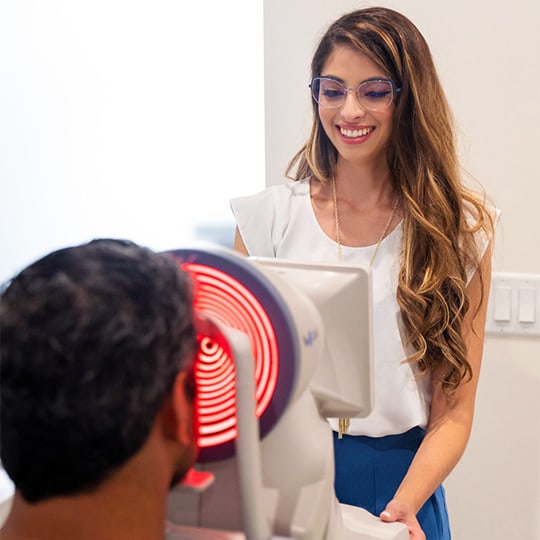Your Destination for Dry Eye Care
Dry eye can be a complicated condition to experience, but Dr. Ferreira and the team at Cypress Optique want to help simplify it. We strive to help you understand, manage, and treat dry eye disease.
To do so, we take a very hands-on approach to educating our patients about dry eye and offer technology such as OptiLIGHT by Lumenis for treatment and relief. With our technology and full-scope dry eye assessments, we aim to provide a comprehensive experience for dry eye care.
Contact us to schedule an appointment and get started on the path to relief from dry eye today.
Book Appointment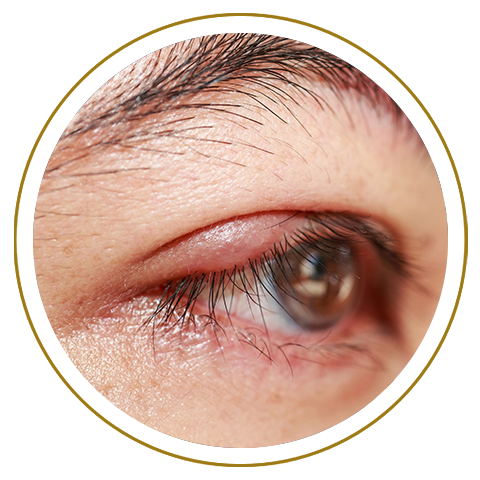

Understanding Your Tear Film
Dry eye is a condition that can be caused by inconsistencies in your tear film, which consists of 3 layers:
- The oily outer layer
- The watery middle layer
- The inner mucus layer
Dry eye can occur when the glands that produce these elements of your tears are not functioning properly or become inflamed. Inflammation and other dry eye symptoms can also be caused by meibomian gland dysfunction (MGD).
Meibomian Gland Dysfunction & Dry Eye
Meibomian gland dysfunction (MGD) is a chronic and progressive condition that can affect the function of the meibomian glands in your eyelids. These glands produce an oily layer that helps lubricate the surface of your eyes and stop your tears from evaporating too quickly.
MGD is a leading cause of dry eye disease around the world, and its symptoms can include:
- Watery eyes
- Fluctuating or blurry vision
- An inability to wear contact lenses or eye makeup
Intense pulsed light (IPL) technology, such as OptiLIGHT by Lumenis, can help treat MGD by gently stimulating your meibomian glands, helping them to release the natural oils needed to lubricate the eyes. We also offer meibomian gland expression as one of our treatment options.
Understanding Ocular Rosacea and Blepharitis
Ocular rosacea and blepharitis are common conditions that can significantly impact the health of your eyes, leading to discomfort and, in some cases, affecting your vision.
While there is no cure for ocular rosacea and blepharitis, proper management could help alleviate symptoms and possibly prevent further complications.
To effectively detect and diagnose conditions such as ocular rosacea and blepharitis, we use a number imaging techniques that provide a clear view of the intricate structures of the eye. These can include meibography and anterior surface imaging.
Ocular Rosacea
Ocular rosacea is an extension of rosacea that affects the eyes, making them appear red and irritated. Up to 41% of individuals with rosacea may experience eye-related symptoms, which can manifest in both eyes.
Symptoms of ocular rosacea include:
- Chronic blepharitis
- Meibomian gland dysfunction
- Corneal damage
Blepharitis
Blepharitis is characterized by inflammation of the eyelid margins, where eyelashes grow. It can be associated with several conditions, including acne rosacea, seborrheic dermatitis, and the presence of Demodex mites in eyelash follicles.
This condition can lead to symptoms such as:
- Red, swollen eyelids
- Itching
- Burning
- The sensation of something in the eye
The Types of Dry Eye
Dry eye is a multi-factorial disease of the eye surface that can be caused by a variety of factors and can generally be classified into 2 main types: aqueous-deficient and evaporative.
These different types of dry eye feature different characteristics and causes. Identifying the specific cause of your dry eye symptoms and the type of dry eye disease affecting your eyes is often crucial for determining the right form of treatment.
Aqueous-Deficient Dry Eye
Aqueous-deficient dry eye occurs when your eyes fail to produce enough of the watery component of your tears.
Aqueous tear deficiency can arise when the lacrimal glands located in your conjunctiva (the thin, clear membrane on your eye’s surface) do not function properly due to various causes, such as autoimmune diseases, medications, obstructions, or damage. As a result, the volume of tears available is insufficient to protect your eyes or provide comfortable and stable vision.
Evaporative Dry Eye
Evaporative dry eye occurs when there is not enough oil in your tears, leading to the quick evaporation of tears from your ocular surface. This condition is more common than other types of dry eye and can cause symptoms such as dryness, irritation, redness, and blurred vision.
Evaporative dry eye occurs when there is an inadequate or unhealthy lipid layer in your tear film, leading to unstable tears. The most common cause of evaporative dry eye is meibomian gland dysfunction (MGD).
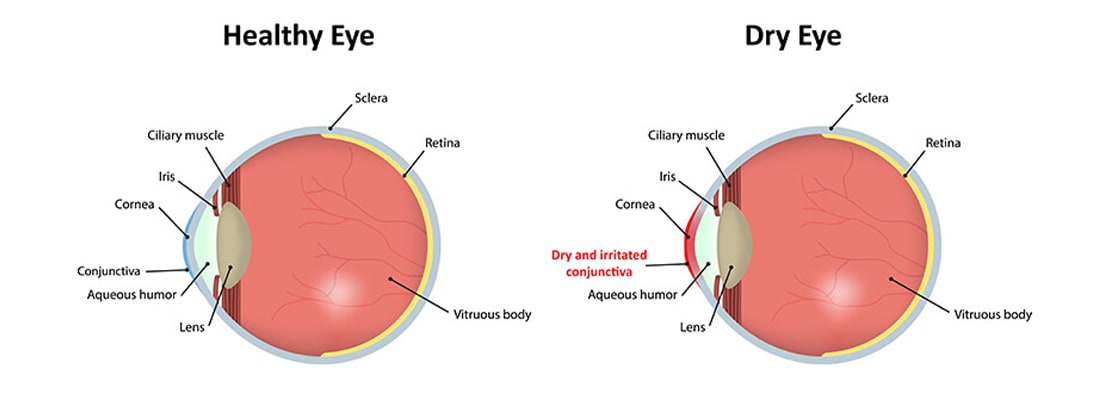
Take Our Dry Eye Questionnaire
Our dry eye questionnaire can help our team learn more about how dry eye disease may be affecting your health and lifestyle before we see you for your appointment.
Take our dry eye questionnaire today.
Our Dry Eye Treatment Methods
Your environment and other risk factors, such as exposure to dry air or wind, long-term contact lens wear, and digital eye strain, can increase your chances of developing dry eye, and we take that all into account when considering your treatment options.
Following our comprehensive diagnostic process to determine your specific needs, our team can work with you to develop a treatment plan that can address what’s causing your symptoms and help you find relief.
We offer treatments such as OptiLIGHT by Lumenis, ZEST treatments, TearCare, and much more. Dr. Ferreira is also happy to answer any questions or concerns you may have about your treatment options.
OptiLIGHT by Lumenis
OptiLIGHT by Lumenis is a light-based, noninvasive treatment done in the area below the eyes to manage dry eye. The first and only IPL FDA-approved for dry eye management.
The treatment is safe, gentle, and is backed by more than 20 clinical studies.
OptiLIGHT uses precise pulses of light to reduce the inflammation that is typically associated with dry eye disease, improve tear break-up time, and increase meibomian gland functionality.
triLift for Dry Eye Relief
triLift is a noninvasive treatment that targets the root causes of dry eye symptoms, providing long-lasting relief. By using radiofrequency technology, triLift stimulates collagen production in the skin around your eyes, improving moisture retention and reducing inflammation.
triLift can provide long-lasting relief for those dealing with persistent dry eye symptoms, offering a holistic approach to both symptom management and underlying causes.
ZEST Lid Microexfoliation
ZEST treatments help exfoliate and debride eyelid margins and lash lines with a special formula created to fight inflammation and kill Demodex mites.
This deep clean can be done with an anesthetic drop to help improve patient comfort and typically only takes 15 minutes. While at-home lid hygiene is important, some people may benefit from a more intensive approach to maintaining their eyelid health.
OptiPLUS Radiofrequency
OptiPLUS radiofrequency (RF) treatments can target the root cause of dry eye disease and provide lasting symptom improvement.
RF treatment can be a safe and efficient way to alleviate the discomfort of dry eye, especially in cases of meibomian gland dysfunction (MGD). Learn more about OptiPLUS by visiting our technology page.
TearCare
The TearCare system is a treatment option designed for individuals with dry eye symptoms caused by meibomian gland dysfunction (MGD). The TearCare device provides localized heat therapy to the meibomian glands located in your eyelids, which can become blocked or inflamed. Localized heat can help reduce blockages to improve tear production and prevent eye discomfort.
Punctal Plugs
Punctal plugs are small devices placed into tear ducts to block the drainage of tears. They can help keep your eyes moist and stop them from drying out too quickly.
Punctal plugs can be an efficient treatment option for getting lasting relief from dry eye symptoms. Dr. Ferreira will work with you to determine whether punctal plugs are right for you.
Meibomian Gland Expression
Meibomian gland expression is a noninvasive procedure that involves applying gentle pressure to your meibomian glands. By expressing trapped oils, the quality and quantity of your tears can improve, leading to fewer dry eye symptoms, such as irritation and watery eyes.
Medicated Eye Drops
Medicated eye drops such as RESTASIS may be an effective treatment option to relieve your dry eye discomfort. Restasis eye drops contain an active ingredient that can help reduce inflammation and increase your eye’s natural ability to produce tears.
Experience Dry Eye Relief Today
At Cypress Optique, we don’t take any shortcuts when it comes to dry eye management. Dr. Ferreira is passionate about dry eye treatment and wants to help you understand and find relief from symptoms like redness, burning sensations, and watery eyes.
We provide detailed testing and a variety of treatment options to support you throughout your dry eye journey. We are here to help you find the path to relief.
Don’t hesitate to get help for dry eyes—contact us to schedule your appointment today.
Book AppointmentVisit Our Clinic

Our Address
- 10920 Fry Road Suite 550
- Cypress, TX 77433
Contact Information
- Phone: 281-942-8520
- Email: [email protected]
Our Hours
- Monday: 8:30 AM – 4:30 PM
- Tuesday: 9:00 AM – 5:00 PM
- Wednesday: 9:00 AM – 5:00 PM
- Thursday: 10:00 AM – 7:00 PM
- Friday: 9:00 AM – 2:00 PM
- Saturday: By Appointment Only
- Sunday: Closed
Our Brands


